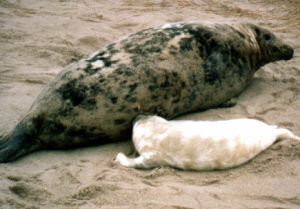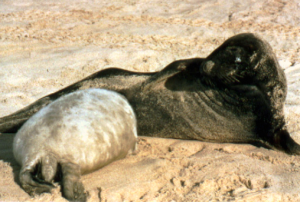
My research interests concern how animals adapt to and exploit their environments and in the physiological and biochemical mechanisms which constrain or provide opportunities for them to do so. My research program is inter-disciplinary, combining comparative physiology and ecology with lipid biochemistry and metabolism in vertebrates, and integrating laboratory and field studies on fundamental issues of interest to both zoological and medical communities, as and which also have implications for conservation and management of mammal, seabird, and fish populations.
The long-term goals of my research program are three-fold: 1) to advance our understanding of the regulation of lipid metabolism in vertebrates, 2) to better understand the physiology of lactation in relation to lipid metabolism and life history variation, and 3) to apply these first two areas and related knowledge to better understand the foraging ecology of free-ranging animals and the ecosystems within which they function.
 Marine mammals, and particularly seals, have been a primary focus of my research because of the critical role that lipid plays in their life histories and especially during lactation and prolonged fasting. Thus, these species provide an excellent model in which to study both fundamental and perhaps limiting aspects of lipid and protein metabolism and lactation, and the interplay and regulation of both.
Marine mammals, and particularly seals, have been a primary focus of my research because of the critical role that lipid plays in their life histories and especially during lactation and prolonged fasting. Thus, these species provide an excellent model in which to study both fundamental and perhaps limiting aspects of lipid and protein metabolism and lactation, and the interplay and regulation of both.
The other main focus of my work is on the use of “fatty acid signatures” as a tool to examine the diets and foraging ecology of marine and terrestrial vertebrates. A major thrust of this research has been to develop the use of fatty acid signatures into a quantitative tool. I have established a large laboratory program which is currently the center for this area of research and hosts active collaborations with many scientists around the world working on various aspects of foraging ecology in harbour seals, grey seals, harp seals, hooded seals and beluga whales in eastern Canada, polar bears throughout the Canadian arctic, northern fur seals, harbour seals, Steller sea lions and seabirds in the Bering Sea and Gulf of Alaska, and endangered Hawaiian monk seals in the Northwest Hawaiian Islands.
 My research program uses a suite of tools ranging from biochemical tracers to energetic measurements to tracking studies to better understand the biology and ecology of marine vertebrates and the food webs within which they function. I am also now the Scientific Director of the Ocean Tracking Network (OTN), both the international joint venture component, funded by the Canadian Foundation for Innovation (CFI), and the OTN Canada Research Network, funded by the Natural Sciences and Engineering Research Council (NSERC).
My research program uses a suite of tools ranging from biochemical tracers to energetic measurements to tracking studies to better understand the biology and ecology of marine vertebrates and the food webs within which they function. I am also now the Scientific Director of the Ocean Tracking Network (OTN), both the international joint venture component, funded by the Canadian Foundation for Innovation (CFI), and the OTN Canada Research Network, funded by the Natural Sciences and Engineering Research Council (NSERC).
